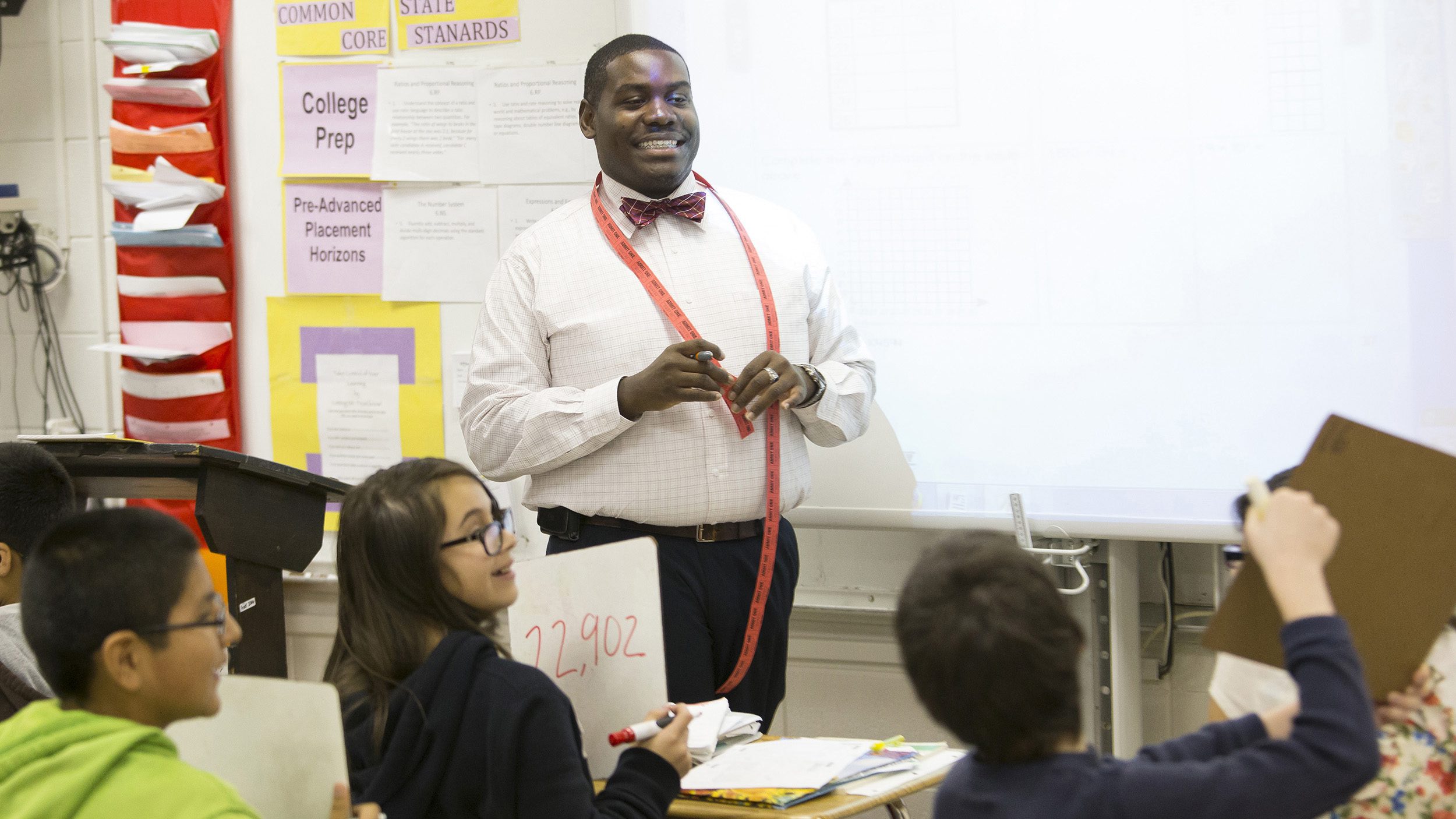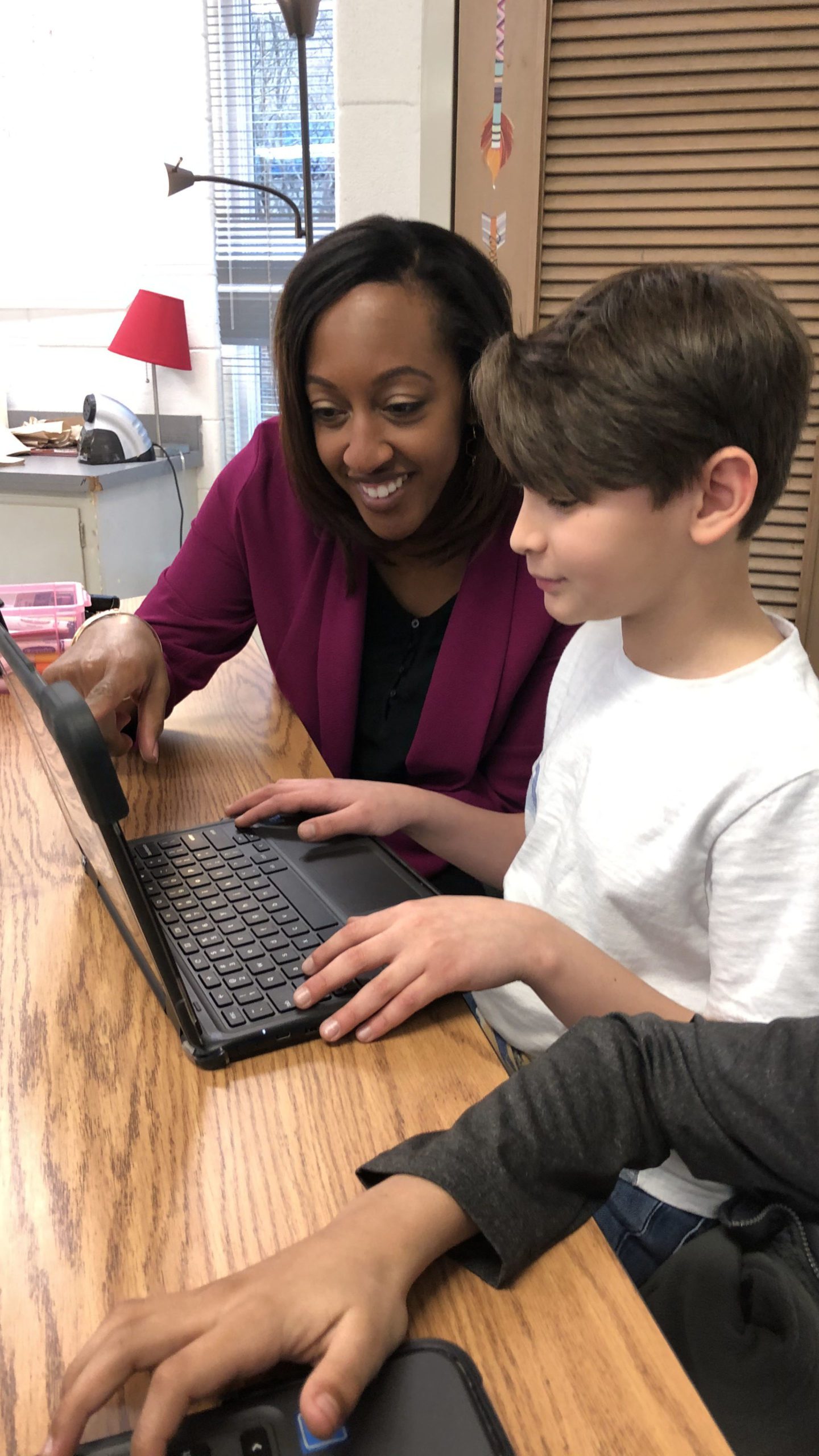Education department hosts panel on diversity in teaching

It wasn’t until Shira Brown ’09 had nearly completed her master’s degree that something occurred to her.
“I realized from my kindergarten year through college, being a black female, I had never had a black teacher in my whole educational career,” she said. “And when I think about that, that’s amazing.”
Now an assistant principal at R.P. Dawkins Middle School in Spartanburg, South Carolina, she sees firsthand how important it is to have diverse teachers and administrators in schools and also how difficult it is to achieve that diversity. That is a big reason she agreed to be one of the panelists at Tuesday night’s “Challenges of Recruiting and Retaining Diverse Teachers,” which was open to the public and held in Plyer Hall’s Patrick Lecture Hall.

Shira Brown ’09 works with a student at R.P. Dawkins Middle School in Spartanburg.
“I’m not seeing a lot of black or diverse teachers going into the field,” she said. “That’s a little disheartening, because it doesn’t match the population of our students.”
The panel discussion was part of the Furman Department of Education’s Centennial celebration and was funded by a Diversity and Inclusion mini-grant. Other panelists include Rima Dakhlallah M’18, literacy coach at Heritage Elementary School in Travelers Rest, South Carolina; Bernard Frost ’05, director of teacher quality and staff development for Spartanburg County School District two; Leonard Galloway M’07 and EdS’13, principal of Glenview Middle School in Anderson, South Carolina; and Sherrie Jeffries M’03, a reading recovery teacher and reading interventionist at Houston Elementary School in Spartanburg.
Shameera Virani, coordinator of Furman’s Teacher Residency Program, was thee moderator.
Brown was born in San Francisco and lived in New Jersey before moving to Columbia, South Carolina, just before high school. She knew she wanted to be a teacher from the time she was an elementary school student and never seriously wavered from the goal despite friends – and her own mind – occasionally trying to talk her out of it.
“My third-grade teacher had a great impact on me … Since then, I’ve loved school and I love kids,” she said. “I think it helped once we started taking the classes (at Furman) where you could get in the classroom. I was seeing the teachers interacting with the kids, and that’s when I stuck the course and knew I wanted to stay in education.”
Brown has seen the value she can have for students who look like her – and their families.
“When black students see a black female in this leadership role, I am able to make connections. Black females will come to my office more, and some parents appreciate that (too),” Brown said. “They feel a little more comfortable I’m not out to get their child when I talk about a choice their child made, so I feel like I have had an impact.”
Brown thinks many factors come into play when it comes to the lack of diversity among teachers and administrators, but an important one may be as simple as students not seeing themselves reflected when they’re in the classroom.
“I think some kids might think education is not for me, because I’ve never seen a teacher who looks like me,” she said. “That’s a real problem, and I don’t know the answer to how to fix that.”
According to Professor of Education Mike Svec, white students are now the minority of the K-12 student population in the country, accounting for 48%, but teachers are still more than 80% white. That doesn’t make for optimal educational outcomes.
“Where that’s important is for the children, representation matters. It’s not that they have to have 100% of their teachers be like them, but having a teacher or two during their school career does matter,” he said. “It results in higher achievement, higher satisfaction and a stronger sense of belonging.”
Svec also hopes current education students of all races will listen to the panelists and remain inspired to continue Furman’s long and proud relationship with Greenville and the surrounding community.
“We’ve provided hundreds of teachers in this county,” he said. “It’s important for (the students) to hear from Furman graduates who represent all of South Carolina and have knowledge about some of the challenges that they’ve overcome and why they persist.”